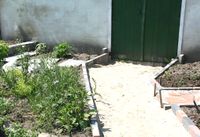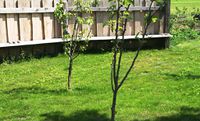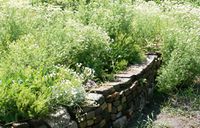Difference between revisions of "Designing your garden"
| (24 intermediate revisions by the same user not shown) | |||
| Line 1: | Line 1: | ||
: ''This is Section 2 of the [[Gardening Seminar:Start your own garden]]. Comments or questions are appreciated. You can also write to [[User:John|John Eagles]].'' | : ''This is Section 2 of the [[Gardening Seminar:Start your own garden]]. Comments or questions are appreciated. You can also write to [[User:John|John Eagles]].'' | ||
| − | [[ | + | [[File:Sissinghurst Castle Garden - The White Garden - geograph.org.uk - 26686.jpg|320px|thumb|right|A well-designed garden. All gardens are different and each garden reflects the character of the designer.]] |
| − | + | Gardens can be designed in many ways. You can get help from professional garden designers<ref>[http://en.wikipedia.org/wiki/Garden_designer Garden designer - Wikipedia]</ref> or even landscape architects<ref>[http://en.wikipedia.org/wiki/Landscape_architect Landscape architect - Wikipedia]</ref>, but of course you can also use your own creativity. | |
| − | + | The more that you know about plants, when they grow, what soil they like etc., the more likely you will be successful and pleased with your garden. But you don't need to be a horticulturist<ref>[http://en.wikipedia.org/wiki/Horticulture Horticulture - Wikipedia]</ref> to be able to make your own great garden. | |
| − | + | I've had gardens or worked in them since my early youth and have developed my own principles and methods for designing a garden. Read about it in the following sections. | |
| − | + | <br clear="all" /> | |
| − | |||
| − | |||
| − | |||
| − | |||
| − | |||
| − | |||
| − | |||
| − | |||
| − | |||
| − | |||
| − | |||
| − | |||
| − | |||
== Creating spheres in a garden == | == Creating spheres in a garden == | ||
| Line 32: | Line 19: | ||
In order to create a sphere for the entire garden, most important is that the garden has a rather clear border. This border doesn't necessarily have to be a visible fence, but it must be clear where the garden begins. Various methods can be used to accomplish this. In extreme cases it may have to be a fence, a wooden fence or a fence made from a hedge or a row of trees. It can also be a natural water stream. In any case, i generally try to put many flowers at the outside borders of my gardens so people who come near my garden are welcomed with beauty. | In order to create a sphere for the entire garden, most important is that the garden has a rather clear border. This border doesn't necessarily have to be a visible fence, but it must be clear where the garden begins. Various methods can be used to accomplish this. In extreme cases it may have to be a fence, a wooden fence or a fence made from a hedge or a row of trees. It can also be a natural water stream. In any case, i generally try to put many flowers at the outside borders of my gardens so people who come near my garden are welcomed with beauty. | ||
| − | All the work that i do is centered on creating and maintaining these spheres. For example, when i am weeding, i do this with respect for the energy of the area where the weeds are growing. Sometimes i let weeds stand, if they contribute to creating the sphere. | + | All the work that i do is centered on creating and maintaining these spheres. For example, when i am weeding, i do this with respect for the energy of the area where the weeds are growing. Sometimes i let weeds stand, if they contribute to creating the sphere that i want. |
In such a garden it is important that your mood is harmonized with the garden. For example, a beautiful garden is not a place to express wild anger. If someone would do so, it would damage the atmosphere in the garden. | In such a garden it is important that your mood is harmonized with the garden. For example, a beautiful garden is not a place to express wild anger. If someone would do so, it would damage the atmosphere in the garden. | ||
| Line 41: | Line 28: | ||
What i tell here is more about attitude than about external principles of design. You can find many of these principles in books, but when you are sensitive to your own garden, you will be guided in designing the garden. | What i tell here is more about attitude than about external principles of design. You can find many of these principles in books, but when you are sensitive to your own garden, you will be guided in designing the garden. | ||
| + | |||
| + | Here follow some photos taken in my own garden: | ||
| + | <gallery caption="" widths="200px" heights="150px" perrow="5"> | ||
| + | File:My garden - entrance to house, in development 120528.JPG|My garden, entrance to backside of the house, in development | ||
| + | File:My garden - heath, wilderness sphere 120528.JPG|My garden, heath and wilderness sphere | ||
| + | File:My garden - lawn with fruit trees and bench 120528.JPG|My garden, lawn with fruit trees and bench, all made or planted recently | ||
| + | File:My garden - rock element 120528.JPG|My garden, rock element | ||
| + | File:My garden - water sphere 120528.JPG|My garden, water sphere | ||
| + | </gallery> | ||
=== A garden of internal or spiritual beauty === | === A garden of internal or spiritual beauty === | ||
| Line 49: | Line 45: | ||
When you create a garden that harmonizes with nature and that you designed and work in with an elevated mind, soon your garden will attract many wild animals. They come, of course for the nectar in the flowers and for the worms etc., but they also feel attracted to the atmosphere in the garden. Animals feel this and respond to this. | When you create a garden that harmonizes with nature and that you designed and work in with an elevated mind, soon your garden will attract many wild animals. They come, of course for the nectar in the flowers and for the worms etc., but they also feel attracted to the atmosphere in the garden. Animals feel this and respond to this. | ||
| − | == | + | === Some practical tips === |
| + | * Walks, especially when you grow vegetables, are not only to walk through the garden, they also are to work on fields. In many cases it is advisable to have your paths on such a distance that you can reach the vegetables, for weeding and harvesting, so you don't need to tread on and compact the soil. | ||
| + | * When you have a lawn, make sure that it is not hollow,--that is, lower in the center than at the borders. | ||
| + | * For flowers you may want to choose the right mix of perennials and annuals so you have blossoming flowers throughout the year. | ||
| + | * For vegetables you may pay attention to have vegetables throughout the year. Some vegetables can withstand frost and other vegetables you can sow already in the harvest or winter or spring before the growing season begins. | ||
| + | * Pay attention to how high trees and bushes grow. Don't place them at the south side of your garden if they cast shadows where you don't want it. | ||
| + | * If you prefer a wild or natural garden, it doesn't mean that you can just let the plants grow as they wish. You'll still need to curb the growth of some plants and stimulate that of others. | ||
| + | * Plant your plants, trees and bushes on the place that they like most. It pays off to take some time to study about the plant. Once they thrive, try to keep them where they are as re-planting them can lead to disappointment. In many cases it's better to adapt the garden around plants that already grow well. | ||
| + | |||
| + | == Elements in gardens == | ||
Here follow examples of elements that you can use to create a beautiful garden. | Here follow examples of elements that you can use to create a beautiful garden. | ||
<gallery caption="" widths="200px" heights="150px" perrow="5"> | <gallery caption="" widths="200px" heights="150px" perrow="5"> | ||
| − | |||
File:P1280267.JPG|Water - a garden pond | File:P1280267.JPG|Water - a garden pond | ||
| − | + | File:Flow forms for the chalice well water - geograph.org.uk - 170593.jpg|Water - flow forms | |
| − | File: | + | File:Composition of flowers in garden.jpg|Flowers composition |
| + | File:Botanical Gardens at Asheville - bench.JPG|Garden bench | ||
| + | File:Waterfall at Rock Garden, Chandigarh.jpg|Rocks | ||
| + | File:Japanese Friendship Garden Path from entrance.JPG|Garden paths | ||
| + | File:Garden terrace at Coleton Fishacre - geograph.org.uk - 811124.jpg|Garden terraces | ||
| + | File:Bogor Botanical Garden lawn.JPG|Garden lawn | ||
| + | File:Contemporarygarden2.jpg|Hard landscaping materials such as stone, hardwood, rendered walls | ||
| + | File:Garden boundary hedges, Myton Crescent - geograph.org.uk - 1336979.jpg|Garden boundary hedges | ||
| + | File:Feuerkorb.jpg|Fire place | ||
| + | File:The Herbaceous Border, Duffryn Gardens (1) - geograph.org.uk - 1406989.jpg|Garden borders | ||
| + | File:Garden House.jpg|Garden houses | ||
</gallery> | </gallery> | ||
| Line 64: | Line 78: | ||
== Next section == | == Next section == | ||
* [[Some science for the gardener]] | * [[Some science for the gardener]] | ||
| + | |||
| + | == See also == | ||
| + | * [[Garden design]] | ||
== References == | == References == | ||
| + | <references /> | ||
| − | |||
== External links == | == External links == | ||
| − | * | + | * [http://www.bbc.co.uk/gardening/design/ BBC Design your garden] |
| + | * [http://en.wikipedia.org/wiki/Garden_design Garden design] Wikipedia | ||
| + | * [http://www.gardendesign.com/ Garden design.com] | ||
| + | * [http://en.wikipedia.org/wiki/History_of_gardens History of gardens] Wikipedia | ||
== Comments == | == Comments == | ||
Latest revision as of 14:58, 28 May 2012
- This is Section 2 of the Gardening Seminar:Start your own garden. Comments or questions are appreciated. You can also write to John Eagles.
Gardens can be designed in many ways. You can get help from professional garden designers[1] or even landscape architects[2], but of course you can also use your own creativity.
The more that you know about plants, when they grow, what soil they like etc., the more likely you will be successful and pleased with your garden. But you don't need to be a horticulturist[3] to be able to make your own great garden.
I've had gardens or worked in them since my early youth and have developed my own principles and methods for designing a garden. Read about it in the following sections.
Creating spheres in a garden
This is my personal approach of designing a garden. There are many other ways to do it, but i can tell better about my own ideas.
In my garden i try to create spheres. What is a sphere in a garden? It has to be understood in a spiritual sense. A sphere is an area in which a certain atmosphere is created and then can be felt and experienced by visitors of the garden.
In my garden i try to create a sphere for the entire garden, and i try to create spheres for parts of the garden, and i try to create a sphere for each different field.
Ideally, when you walk through my garden, you sometimes get the feeling of being in a forest, and then to walk over a heath, and you can sit at a pond, or hear the wheat whisper in the wind.
In order to create a sphere for the entire garden, most important is that the garden has a rather clear border. This border doesn't necessarily have to be a visible fence, but it must be clear where the garden begins. Various methods can be used to accomplish this. In extreme cases it may have to be a fence, a wooden fence or a fence made from a hedge or a row of trees. It can also be a natural water stream. In any case, i generally try to put many flowers at the outside borders of my gardens so people who come near my garden are welcomed with beauty.
All the work that i do is centered on creating and maintaining these spheres. For example, when i am weeding, i do this with respect for the energy of the area where the weeds are growing. Sometimes i let weeds stand, if they contribute to creating the sphere that i want.
In such a garden it is important that your mood is harmonized with the garden. For example, a beautiful garden is not a place to express wild anger. If someone would do so, it would damage the atmosphere in the garden.
Each plant, each element in the garden, such as a pond with water, a blossoming fruit tree, a rock, a bench to sit on, they contribute to creating a sphere in your garden. Therefore, each element must be placed at the right location.
When i plant a new plant, i go through the garden and ask the plant where it belongs. Eventually, that plant finds its best place and there i plant it. I do the same when placing a bench, or adding a water element.
What i tell here is more about attitude than about external principles of design. You can find many of these principles in books, but when you are sensitive to your own garden, you will be guided in designing the garden.
Here follow some photos taken in my own garden:
A garden of internal or spiritual beauty
The principles of design described here are to create a garden of internal or spiritual beauty. Such a garden will be in harmony with the house it surrounds. It will help you to feel better inside the house. Such a garden is to create a world of health and harmony and beauty in your own little world.
This internal beauty is composed from various elements. Most important is your own mood with which you work in the garden. If you work in a garden thinking to save or earn some money, your garden will reflect those thoughts. If you work in a garden and your emphasis is on healing people, then your garden will become a medicinal garden, both in a physical and spiritual way.
When you create a garden that harmonizes with nature and that you designed and work in with an elevated mind, soon your garden will attract many wild animals. They come, of course for the nectar in the flowers and for the worms etc., but they also feel attracted to the atmosphere in the garden. Animals feel this and respond to this.
Some practical tips
- Walks, especially when you grow vegetables, are not only to walk through the garden, they also are to work on fields. In many cases it is advisable to have your paths on such a distance that you can reach the vegetables, for weeding and harvesting, so you don't need to tread on and compact the soil.
- When you have a lawn, make sure that it is not hollow,--that is, lower in the center than at the borders.
- For flowers you may want to choose the right mix of perennials and annuals so you have blossoming flowers throughout the year.
- For vegetables you may pay attention to have vegetables throughout the year. Some vegetables can withstand frost and other vegetables you can sow already in the harvest or winter or spring before the growing season begins.
- Pay attention to how high trees and bushes grow. Don't place them at the south side of your garden if they cast shadows where you don't want it.
- If you prefer a wild or natural garden, it doesn't mean that you can just let the plants grow as they wish. You'll still need to curb the growth of some plants and stimulate that of others.
- Plant your plants, trees and bushes on the place that they like most. It pays off to take some time to study about the plant. Once they thrive, try to keep them where they are as re-planting them can lead to disappointment. In many cases it's better to adapt the garden around plants that already grow well.
Elements in gardens
Here follow examples of elements that you can use to create a beautiful garden.
Back
- Gardening Seminar:Start your own garden to go to the other sections of this seminar.
- What is a garden to go to the former section of this seminar
Next section
See also
References
External links
- BBC Design your garden
- Garden design Wikipedia
- Garden design.com
- History of gardens Wikipedia
Comments
- Coming soon



















